-
Paper Information
- Next Paper
- Previous Paper
- Paper Submission
-
Journal Information
- About This Journal
- Editorial Board
- Current Issue
- Archive
- Author Guidelines
- Contact Us
International Journal of Materials Engineering
p-ISSN: 2166-5389 e-ISSN: 2166-5400
2016; 6(2): 39-46
doi:10.5923/j.ijme.20160602.03

Repair Methods Indication for a Timber Coverage Structure Located in Sinop City - Brazil
Roberto Vasconcelos Pinheiro1, Luiz G. F. Lázaro1, Laurenn Borges Macedo2, André Luis Christoforo3, Francisco Antonio Rocco Lahr4
1Department of Civil Engineering, State University of Mato Grosso (UNEMAT), Sinop, Brazil
2Department of Materials (SMM), São Paulo University (EESC/USP), São Carlos, Brazil
3Centre for Innovation and Technology in Composites – CITeC, Department of Civil Engineering (DECiv), Federal University of São Carlos (UFSCar), São Carlos, Brazil
4Department of Structural Engineering (SET), São Paulo University (EESC/USP), São Carlos, Brazil
Correspondence to: André Luis Christoforo, Centre for Innovation and Technology in Composites – CITeC, Department of Civil Engineering (DECiv), Federal University of São Carlos (UFSCar), São Carlos, Brazil.
| Email: |  |
Copyright © 2016 Scientific & Academic Publishing. All Rights Reserved.
This work is licensed under the Creative Commons Attribution International License (CC BY).
http://creativecommons.org/licenses/by/4.0/

Brazil has large forest vocation in construction, however, the difficulty in obtaining adequately trained professionals associated with lack of knowledge about the physical and mechanical properties, no appropriate treatment against insects and fungi, among others, confirm the reduction of durability materials and consequently the projected structure. In order to contribute effectively in reducing disease and spread the application of concepts of prevention methods to timber structures by professionals of construction in Brazil and other countries, this research aimed, through a case study carried out in a cover structure (made with Itaúba wood specie - Mezilaurusitaub meisn) located in the Midwestern region of Brazil, Mato Grosso, in the city of Sinop (11°50'5,5 S; 55°30'4,2 W), identify pathologies present in the structure, identify possible causes and point out the most appropriate methods for repair. The cover structure has the following characteristics: Ceramic roof; truss structure of Howe type with 23° inclination; dimensions plant with 14m in width and length of 32,5m; spacing between trusses 2.5m; strips with dimensions of 2,5×5,0cm2 rafters: 5,0×6,0cm2; purlins: 5,0×15,0cm2; diagonal: 5,0×10,0cm2; amounts: 2 pieces with 2,5×15,0cm2; upper and lower flanges: 5,0×15,0cm2 and steel joints made with through bolts. Thus, it is expected that in the near future, this study effectively contribute to the reduction of pathologies, and spread the application of concepts and prevention methods to repair the structures, contributing positively by spreading the use of wood in the design of structures.
Keywords: Timber, Cover structure, Pathologies, Preventive methods
Cite this paper: Roberto Vasconcelos Pinheiro, Luiz G. F. Lázaro, Laurenn Borges Macedo, André Luis Christoforo, Francisco Antonio Rocco Lahr, Repair Methods Indication for a Timber Coverage Structure Located in Sinop City - Brazil, International Journal of Materials Engineering , Vol. 6 No. 2, 2016, pp. 39-46. doi: 10.5923/j.ijme.20160602.03.
1. Introduction
- Wood is a material of vegetable origin and organic, being a raw material that can be produced anywhere in the world, coming from completely renewable and abundant sources such as natural tropical forests and planted and, therefore, that material has always been present in Brazilian buildings.However, in general, Brazil has large forest vocation in civil construction, nonetheless, the difficulty of obtaining properly qualified professionals to develop specific projects of wooden structures and monitoring this construction, the lack of knowledge of physical-mechanical and natural properties of some wood species, the inappropriate use of the material and the lack of knowledge of the methods that prolong its useful life, corroborates in the reduction of durability and has leaded, prematurely, the occurrence of pathologies affecting the aesthetic- functional aspect, besides fomenting the prejudice on the quality and use of same.For the use of wood as a structural material, it expects some extremely important qualities, as natural durability and maintenance of the physical and mechanical properties over the course of use. Though, it is known case that the use of wood as a structural material requires cares to minimize the problems related to the decrease of mechanical properties over the years. It is noteworthy that such properties are directly influenced by moisture content (physical property) and vary according to species. Furthermore, the addition of the same due to exposure of the wood in contact with water or humid environments, is responsible for reducing the resistance properties of wood [1-7].According to [8], the pathology of the building is nothing more than the study of the identification of the problems encountered as well the causes, being developed correction and a diagnosis. In accordance with [9], the pathology is the study of causes and symptoms, the origins of the civil construction effects, so being a study of the steps involved in the diagnosis of the problem raised.The pathologies of wood are the result of using in unacceptable states and loss of resistant capacity, which can occur by three actions: human, natural or accidental [10].The causes of pathologies originating from human actions can be classified into three phases:a) Phase Conception and Project: poorly designed, incorrect calculations and incomplete list of materials;b) Construction Phase: poor quality of materials, poor project execution and lack of technical skills;c) Phase of Use: absence of geometry, unsuitable or absent maintenance and modification of the conditions of use.Pathologies arising from natural actions are caused mainly by natural and deteriorative agents defects. The deterioration coming from the natural defects (irregular grain, presence of knots, reaction wood, false hardwood, ring crevices and pockets of resin) is directly related to the type of species and also in the form of growth. According to [11], about the deteriorative agents of wood, are divided into two groups, namely, the abiotic agents and biotic. These agents can cause from simple change of color to reduction of physical and mechanical wood properties, which can compromise the architectural and structural performance of the pieces. Abiotic agents can be divided into mechanical (abrasion effect), physical (fire), chemicals (chemical substances) and climate (humidity, temperature, solar radiation and wind), while agents of biological origin (biotic agents) are considered the main deteriorative of wood, [12]. The main organisms that attack wood are decay fungi, drills and termites, [11].The types of pathologies caused by accidental actions are highly variable and depend on the intensity of their cause. In this case, are cited fires, earthquakes, explosions, floods and shocks.In addition to the topics mentioned above, also arise pathologies in wooden structures, related to lack of periodic maintenance and, in face of this, the structures can achieve the serviceability limit states (excessive deformation) and last (rupture - structural elements and connections; global instability and local), being necessary the partial or complete repairs to structures [13-15].Thus, it is understood that the periodic preparation of a diagnosis of the conservation status becomes necessary, for intervention proposals (prognostic) be prepared in proactive way [16, 17].It is well known case, preservation is all set providences that may give the wood resistance to deterioration agents, conditioning greater durability. According to Law No. 4,797 of 1965 and the joint normative instructions IBAMA and National Agency of Surveillance (ANVISA) the wood preservative treatment is mandatory for wooden structures under conditions that contribute to the reduction of its useful life. According to [11], the preservative treatments are mainly intended to protect any wooden pieces against possible decay actions, whether they arising from natural phenomena (biotic or abiotic) or physico-chemical phenomena.To prevent the proliferation of wood-destroying organisms, can be adopted some wood preservation techniques, as the natural preservation, indirect, biological and chemical. Therefore, it is public knowledge that some species are more susceptible to wood-destroying organisms attacks, requiring some care to prevent the biological demand. Among them, the chemical preservation stands out as being the most efficient method against deterioration of wood [3, 18, 19, 20]. Based on the literature, the preservation method through of using chemicals in the preventive treatment (pre-treatment, homemade process (without vacuum / pressure), industrial processes (vacuum / pressure)) and dressing is the most suitable. Such treatments are well discussed by [11].In the middle of this scenario, the study by proposed case was held in the Central-West region of Brazil, State of Mato Grosso, in the city of Sinop, specifically covering structure of Sinop Forest Park (11º50´5.5” S; 55º30´4.2” W). The main objective was to identify and to diagnose the nature and types of causative agents of pathologies instituted in the structure under study and, subsequently, to suggest appropriate methods curative and preventive (prognosis) to promote an increase in lifetime of the structure.From there, it is expected that in the near future, this study effectively contribute to the reduction of instituted pathologies, and, promote the dissemination and internalization of applying concepts of prevention methods to structures.
2. Material and Methods
- For the execution of this work were used some materials, so much in the literature review, as well as in field of steps. In the literature review had as sources, the collection of the State University of Mato Grosso and the web, like, monographs, books, theses and articles. Besides these, a 18 megapixel camera Sony semi-professional was used and another equipment’s (ladder, tape measure, bubble level, props, etc.).Wooden structures require careful and frequent maintenance. When it comes to the time to carry out further actions of rehabilitation, of buildings, in methodological terms, the greatest difficulty lies in the decision to restore, rehabilitate or replace the original solution by a new most appropriate solution to the use. Hence, in this study it was necessary to subdivision into three parts. At first, an inspection was carried out on the coverage structure. In the second part, the diagnosis was studied (causes of pathology) and, in the third, the prognosis (forms of maintenance and recovery) was developed.The inspection of the coverage structures occurred in December 2014. Through this stage, it was possible to determine the position of structures in relation to possible pathologies. The inspection occurred according to the following steps:a) Elaboration of a record of history, of the environment and structure, by visiting the work and checking the documentation: the company has no executive projects of the coverage structure and, thus, it was not allowed the identification, indirectly, of geometric parameters and the specie wood used. In this way, all the dimensions of the building, well as structural pieces were in loco measures. Furthermore, wood species identification employed in the structure was performed with the support of cataloged records of wood species of the Institute of Technological Research (IPT);b) Inspection (visual and photographic) of the structure: visual analyzes were performed in loco in the latticed structures, in the structural components of wood and connections of structural pieces (performed with metal parts). Also, it was evaluated the general conditions of structure, in other words, the mounting details, stability and deformation of the elements, deteriorating conditions in use of the structure, among others.At this stage, was held on the interpretation of each mapped case, determining the causes (origin) and effects (consequences) of pathologies.After the diagnosis of pathologies, were defined forms of maintenance, restoration and replacement to be adopted in each case, through from the survey of evolution assumptions of the problem. For the determination of the prognosis it was adopted the following procedures:a) Type of pathology;b) Level of evolution of pathology;c) Exposure conditions.From the elaboration of the prognosis, it was analyzed the intervention alternatives together with pathological problems, in the following manner:a) Eradicating the disease;b) Prevent or control its evolution;c) Replace partially or totally the wooden pieces and connectors.
3. Results and Discussion
- The result of this work is guided in the assessment, identification of the causes of diseases instituted and the preventive and curative solutions thereof, through interventions in a wooden structure, address all the elements that compose it.As from the visual inspection, were observed the following constructive features of the evaluated structure:a) Species used: Itaúba - Mezilaurus Itauba (Meisn);b) Roof type: Ceramic;c) Type of structure: lattice type "Howe", with 23° of inclination, composed of chord (upper and lower), diagonal and studs, with the vertical and horizontal shares transferred to the foundation through of the pillars;d) Building dimensions: plant of 14m (width) × 32,5m (length);e) Spacing between lattices: 2.5m;f) Transverse dimensions of the structural elements: slats: 2,5×5,0 cm²; rafters: 5,0×6,0 cm²; purlins: 5,0×15,0 cm²; diagonal: 5,0×10,0 cm²; central stud: 5,0×15,0 cm²; other studs: 2 pieces 2,5×15,0 cm²; chord (upper/lower): 5,0×15,0 cm²;g) Length of the structural elements (Figure 1);h) Connections: metal hook (between central stud and inferior chord); nails (among other studs and chords); notch (between diagonal and chords); sheet metal and through-bolts (amendments of the chords);i) Bracing Structure: rafters of 5.0×6.0 cm², executed in vertical planes "X" joining the knots of the chords (upper/lower) among all latticed structures.
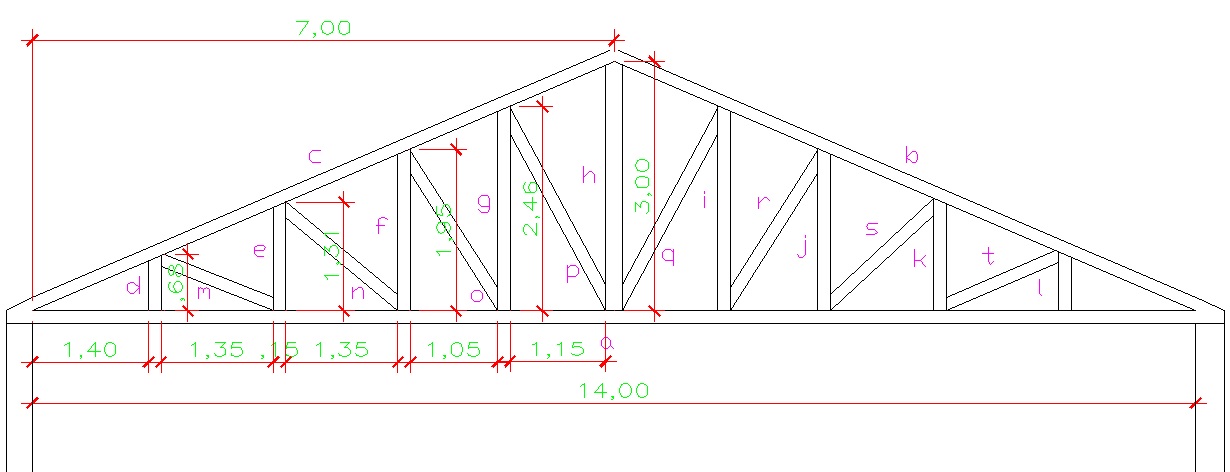 | Figure 1. Geometry of the lattice (schematic) |
 | Figure 2. Pieces (rafters, girders and lattice bars) degraded by the action of termites |
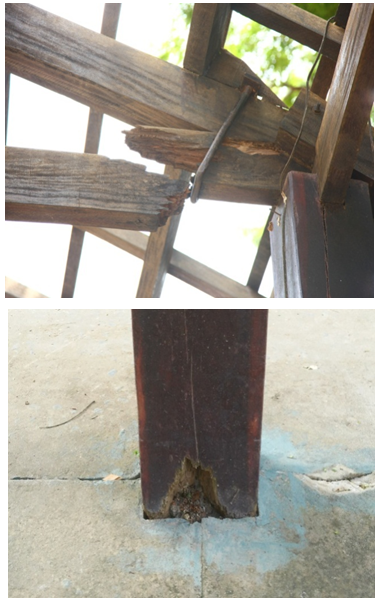 | Figure 3. Pieces (girders, lattice bars and pillars) degraded by action of decay fungus |
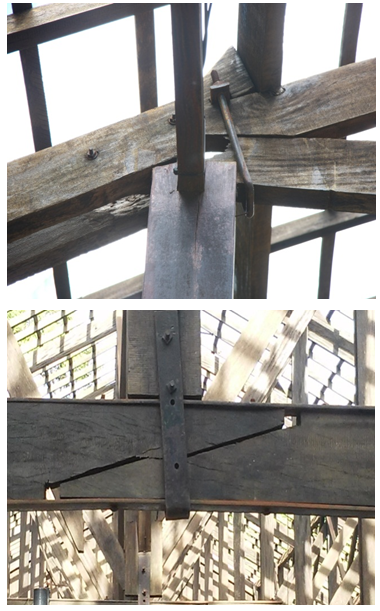 | Figure 4. Connections - regions of support and middle of the span |
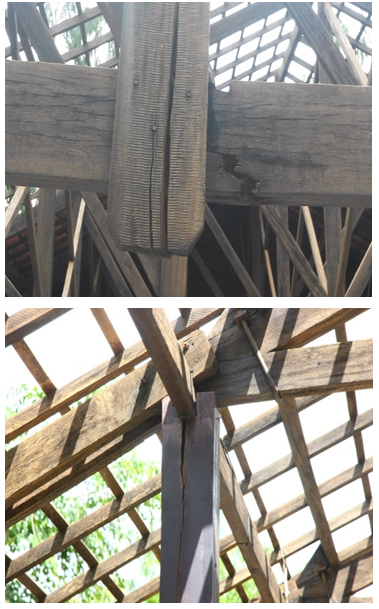 | Figure 5. Structural elements in ruin (lattice bars and columns) |
 | Figure 6. Vertical bracing system |
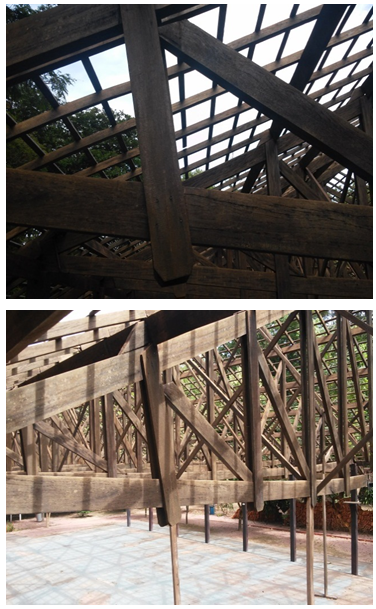 | Figure 7. Bracing vertical system |
4. Conclusions
- After visual analysis/ technical of coverage structure, it is concluded that:- There were deterioration of wood pieces (lattice bars; girders; pillars) by biological agents (termite and decay fungus), with the necessity of replacement of the parts;- There was a rupture of lattice bars for traction and shear / cracking;- There was rupture / plastic deformation of the connections between bars of the chords;- There was loss of global stability of some lattices, in the face of misunderstanding in the design and implementation of bracing system;- The local instability, referring to some lattice bars (upper chord, central stud and diagonal), do not attend the requirements of [21];- There was excessive vertical displacement of the lattice.However, it is noteworthy that several lattices can be reused, if adopted corrective actions mentioned here. With this, it is expected that this study will effectively contribute to reducing of pathologies, as well as promote the dissemination and internalization of concepts of application of the calculation methods and prevention to structures.
 Abstract
Abstract Reference
Reference Full-Text PDF
Full-Text PDF Full-text HTML
Full-text HTML